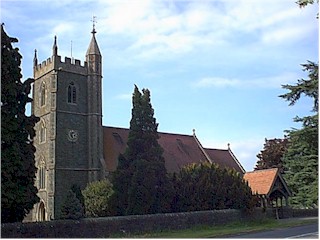Bristol Rural Branch
Alveston (St Helen)

Name or Dedication: St Helen
Location: Alveston, Gloucestershire
Grid Reference: ST633875
The second and third bells of this ring were originally the tenors to a Medieval ring of three at Alveston's old Parish Church of St Helen, Rudgeway. They were transferred here in 1885 when the present church was built, and incorporated into the new ring of six. There is no evidence of them ever having been tuned. The other four (1885) bells are dedicated to Edward Bush, local benefactor, who paid for the new church and bells.
The bells still hang in their original 1885 oak frame. Originally on plain bearings, they were rehung on ball bearings with all new fittings including cast iron box-section headstocks and new clappers, and the frame strengthened with additional bolts, by Whitechapel in the early 1980s. The Ellacombe Chiming Apparatus was also removed from the ground floor of the tower at this time. The third bell has had its canons removed, probably by Llewellins & James in 1885, and as their bells were cast with flat crowns, only the second has a canon-retaining headstock. The frame has an unusual layout, with potentially space for a seventh bell in the south-west corner where the clock weights used to fall.
In a large and somewhat intrusive cupboard in the Ringing Room is a cast iron flatbed clock. Built by J.W. Benson of Ludgate Hill, London in 1886 and given by the venerable Edward Bush, it features a ting-tang quarter chime on the treble and third bells and an hourly strike on the tenor. Its dial is on the south wall of the tower, directly behind the movement. Originally hand-wound with weights dropping the full height of the belfry and Ringing Room, all three trains now have Huygens Auto Winders and the hammers are pulled clear of the bells by electric motors – this probably dates from the 1980s rehanging of the bells.
Bells hung for full-circle ringing
| Bell | Weight | Diameter | Note | Founder | Date |
|---|---|---|---|---|---|
| 1 | 4¾ cwt | 28½ in | D# | Llewellins & James | 1885 |
| 2 | 5 cwt | 30 in | C# | Bristol Foundry | c.1420-50 |
| 3 | 7 cwt | 34 in | B | John Pennington I | 1635 |
| 4 | 9 cwt | 36 in | A# | Llewellins & James | 1885 |
| 5 | 11 cwt | 39 in | G# | Llewellins & James | 1885 |
| 6 | 14¼ cwt | 42 in | F# | Llewellins & James | 1885 |
Source: Bell data and information from Nick Bowden, Andrew Bull and Paul Grainger-Allen; weights estimated personally. Strike notes of treble and third bells recorded personally 24th October 2006 as the clock chimed the quarter-hour. Bells and clock inspected personally 12th December 2006.
Where the exact weight of a bell is known, it is given in the traditional way using the British imperial units of Hundredweight, Quarters and Pounds (cwt-qtr-lb) in which there are 28 pounds in a quarter, four quarters in a hundredweight, and 20 hundredweight in a ton (one hundredweight is equal to approximately 50.8 kilograms). However, if only an approximate or calculated weight is known, it is given to the nearest quarter of a hundredweight.
A bell's diameter is measured across its mouth (open end) at the widest point and is given in inches (to the nearest quarter of an inch), one inch being equal to approximately 2.54 centimetres.
 Skip to:
Skip to: